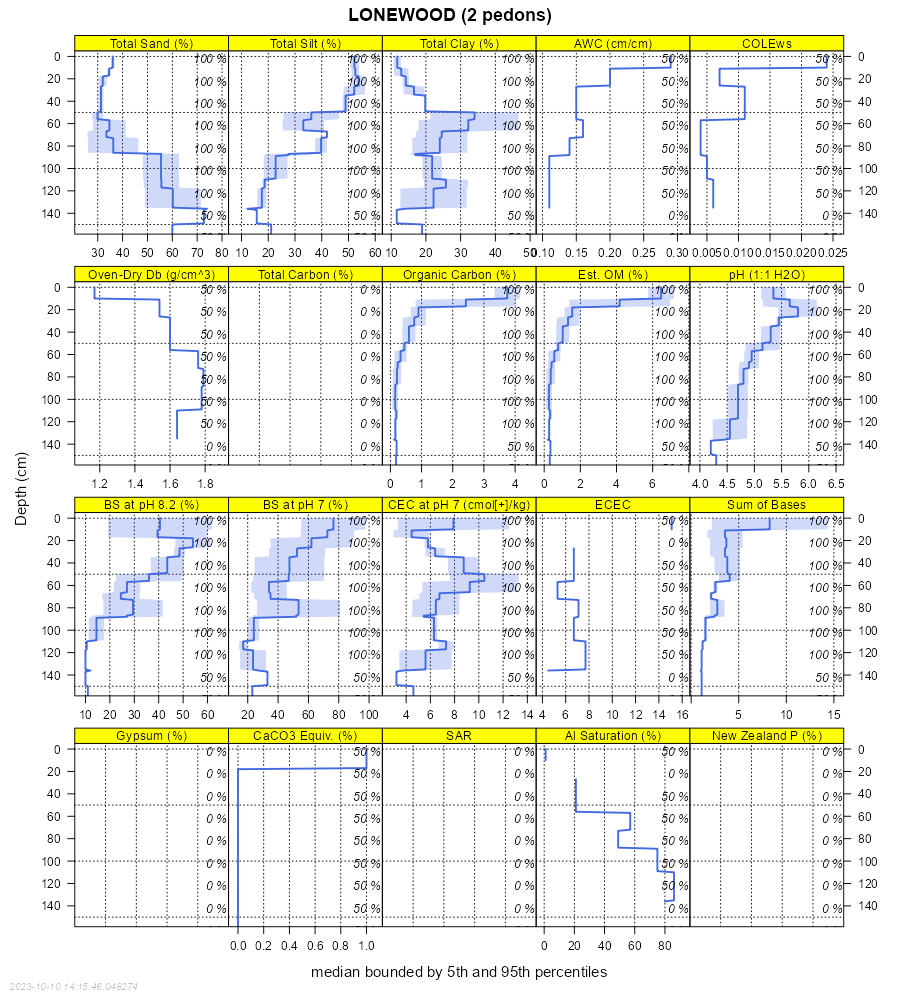| Lonewood loam, 6 to 12 percent slopes | LoC | 303 | 1592497 | 1qg3w | ky001 | 2006 | 1:12000 |
Lonewood loam, 2 to 6 percent slopes | LoB | 154 | 1592496 | 1qg3v | ky001 | 2006 | 1:12000 |
Lonewood loam, 6 to 12 percent slopes, eroded | LoC2 | 867 | 552527 | ljyg | ky051 | 1994 | 1:24000 |
Lonewood loam, 2 to 6 percent slopes | LoB | 208 | 552526 | ljyf | ky051 | 1994 | 1:24000 |
Dewey-Lonewood complex, 12 to 25 percent slopes | DmD | 13665 | 551442 | lhtg | ky057 | 1991 | 1:20000 |
Caneyville-Lonewood complex, rocky, 6 to 25 percent slopes, eroded | CaD2 | 7830 | 551434 | lht6 | ky057 | 1991 | 1:20000 |
Lonewood silt loam, 6 to 12 percent slopes, eroded | LdC2 | 3280 | 551458 | lhtz | ky057 | 1991 | 1:20000 |
Lonewood silt loam, 2 to 6 percent slopes | LdB | 605 | 551457 | lhty | ky057 | 1991 | 1:20000 |
Lonewood loam, 2 to 6 percent slopes | LoB | 15720 | 552494 | ljxd | ky207 | 1979 | 1:20000 |
Lonewood loam, 6 to 12 percent slopes | LoC | 4270 | 552495 | ljxf | ky207 | 1979 | 1:20000 |
Lonewood silt loam, 4 to 12 percent slopes | LwC | 156 | 524446 | klqm | tn015 | 1999 | 1:24000 |
Caneyville-Lonewood complex, 6 to 25 percent slopes, eroded, rocky | CaD2 | 1807 | 531105 | ktnf | tn027 | 2002 | 1:24000 |
Lonewood loam, 5 to 12 percent slopes | LwC | 15659 | 523888 | 2tnvr | tn035 | 1998 | 1:24000 |
Lonewood loam, 2 to 5 percent slopes | LwB | 2734 | 523887 | 2tnvb | tn035 | 1998 | 1:24000 |
Lily-Lonewood complex, 5 to 12 percent slopes, rocky | LnC | 1060 | 523886 | 2w2ns | tn035 | 1998 | 1:24000 |
Lonewood silt loam, 2 to 5 percent slopes | LoB | 21532 | 525254 | 2tnvf | tn061 | 1990 | 1:24000 |
Lonewood silt loam, 5 to 12 percent slopes | LoC | 8682 | 525255 | 2tnvj | tn061 | 1990 | 1:24000 |
Lonewood silt loam, 2 to 6 percent slopes | LnB | 4993 | 1017869 | 2w2nx | tn065 | 1980 | 1:15840 |
Linker loam, rolling phase (Lonewood) | Lb | 1757 | 526283 | knmw | tn115 | 1951 | 1:20000 |
Linker loam, eroded rolling phase (Lonewood) | Lc | 242 | 526284 | knmx | tn115 | 1951 | 1:20000 |
Lonewood loam, 5 to 12 percent slopes | LwC | 9347 | 843370 | 2tnvr | tn133 | 2003 | 1:24000 |
Lonewood loam, 2 to 5 percent slopes | LwB | 2755 | 843369 | 2tnvb | tn133 | 2003 | 1:24000 |
Lonewood-Hendon complex, 5 to 12 percent slopes | LnC | 3360 | 728872 | sgg0 | tn143 | 2003 | 1:24000 |
Lonewood-Hendon complex, 2 to 5 percent slopes | LnB | 912 | 728871 | sgfz | tn143 | 2003 | 1:24000 |
Lonewood silt loam, 5 to 12 percent slopes | LoC | 116 | 1473797 | 2tnvj | tn145 | 2005 | 1:24000 |
Lonewood silt loam, 2 to 5 percent slopes | LoB | 105 | 1473796 | 2tnvf | tn145 | 2005 | 1:24000 |
Lonewood silt loam, 5 to 12 percent slopes | LoC | 7352 | 529628 | 2tnvj | tn153 | 1995 | 1:24000 |
Lonewood silt loam, 2 to 5 percent slopes | LoB | 5466 | 529627 | 2tnvf | tn153 | 1995 | 1:24000 |
Lonewood-Lily complex, 5 to 12 percent slopes | LwC | 7896 | 2450738 | 2tnv1 | tn177 | 1965 | 1:15840 |
Lonewood loam, 2 to 5 percent slopes | LoB | 2303 | 2450722 | 2tnvb | tn177 | 1965 | 1:15840 |
Lonewood loam, 5 to 12 percent slopes | LdC | 42786 | 2454166 | 2tnvr | tn604 | 1974 | 1:20000 |
Lonewood silt loam, 5 to 12 percent slopes | LoC | 15082 | 528661 | 2tnvj | tn604 | 1974 | 1:20000 |
Lonewood silt loam, 2 to 5 percent slopes | LoB | 3872 | 528660 | 2tnvf | tn604 | 1974 | 1:20000 |
Lonewood-Lily complex, 5 to 12 percent slopes | LeC | 3046 | 2441404 | 2tnv1 | tn604 | 1974 | 1:20000 |
Lonewood-Lily complex, 2 to 5 percent slopes | LeB | 2416 | 2454164 | 2w2nw | tn604 | 1974 | 1:20000 |
Linker loam, 5 to 12 percent slopes, eroded | LrC2 | 438 | 2427467 | 2mgzd | tn610 | 1960 | 1:15840 |
Linker loam, 5 to 12 percent slopes | LrC | 218 | 2427466 | 2mgzc | tn610 | 1960 | 1:15840 |
Lonewood silt loam, 5 to 12 percent slopes | LoC | 5556 | 2439107 | 2mw2w | tn629 | 2003 | 1:24000 |
Lonewood silt loam, 2 to 5 percent slopes | LoB | 2296 | 2439106 | 2mw2v | tn629 | 2003 | 1:24000 |
Lonewood silt loam, 5 to 12 percent slopes | LoC | 1518 | 1707751 | 1vb1r | tn650 | 2008 | 1:12000 |
Lonewood silt loam, 2 to 5 percent slopes | LoB | 740 | 2406082 | 2lrqk | tn650 | 2008 | 1:12000 |
Lonewood-Clarkrange complex, 2 to 6 percent slopes | LoC | 26307 | 2439175 | 2mw52 | tn701 | 1985 | 1:24000 |















